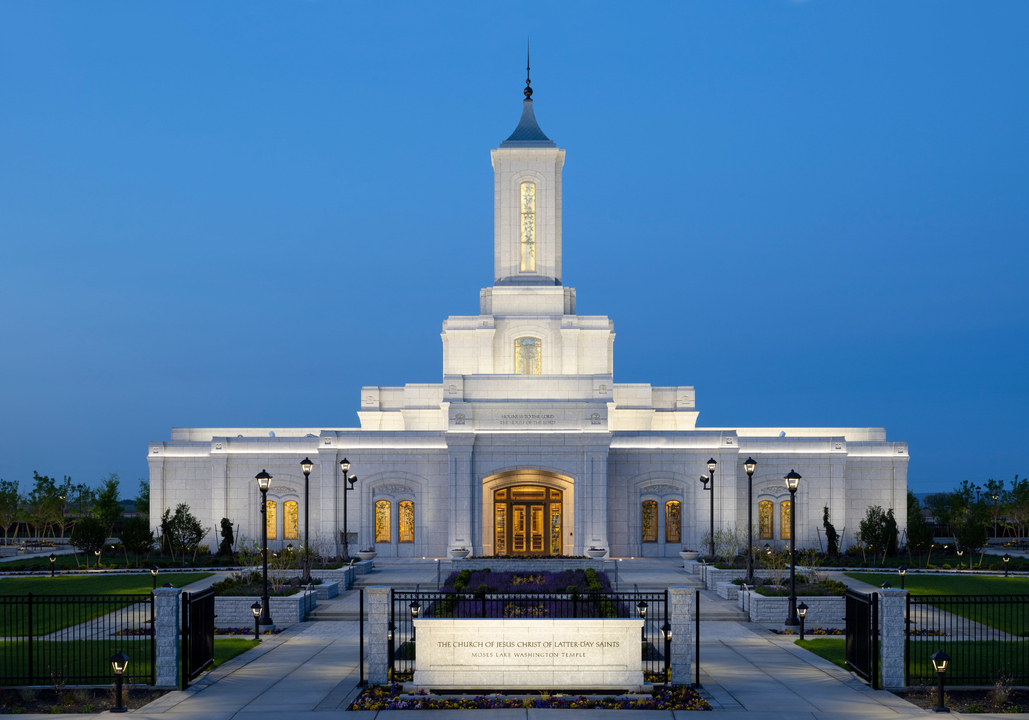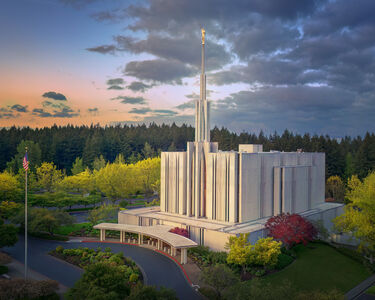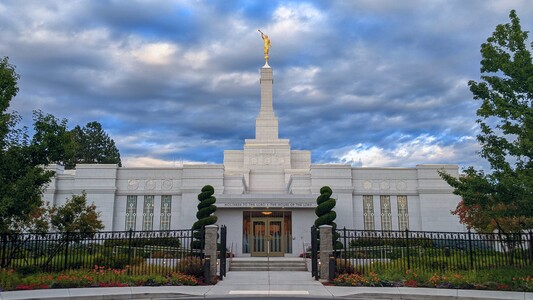Services
NO visitors' center open to the publicNO arrival center available
NO patron housing available
Distribution center on site (Store Locator)
Announcement:
7 April 2019Groundbreaking and Site Dedication:
10 October 2020 by David L. StapletonPublic Open House:
4–19 August 2023Dedication:
17 September 2023 by Quentin L. CookSite:
17.2 acres | 7.0 hectaresExterior Finish:
Branco Cristal granite quarried in PortugalArchitectural Features:
Single attached central spireOrdinance Rooms:
Two instruction rooms, two sealing rooms, and one baptistryTotal Floor Area:
28,933 square feet | 2,688 square metersHeight:
117 feet 6 inches | 35.8 metersElevation:
1,157 feet | 353 metersTemple Facts
The Moses Lake Washington Temple was the fourth temple built in Washington, following the Seattle Washington Temple (1980), the Spokane Washington Temple (1999), and the Columbia River Washington Temple (2001).
Temple History
Announcement
On April 7, 2019, at the 189th Annual General Conference, President Russell M. Nelson announced Washington's fourth temple to be constructed in the scenic community of Moses Lake. Members in the region were attending temple services at the Columbia River Washington Temple, located in the rapidly growing Tri-Cities area. There were nearly 290,000 Latter-day Saints in Washington.1
Site
On October 29, 2019, the location for the Moses Lake Washington Temple was officially announced as a 17-acre property across from Yonezawa Park and near Moses Lake High School. The deed that transferred ownership of the two contiguous lots, dated June 19, 2019, noted that the land was being sold for a future church. The location, just a mile and a half west of the junction of I-90 and Highway 17, would provide convenient access to patrons traveling from the surrounding region. Standing on the north side of I-90, south of Yonezawa Boulevard, the temple would become a beautiful landmark to travelers along these major routes.
Rendering
On April 7, 2020, an official exterior rendering of the Moses Lake Washington Temple was released. Plans called for a single-story building of approximately 20,000 square feet with a central spire. A meetinghouse of approximately 17,000 square feet would also constructed next to the temple.
Groundbreaking
Elder David L. Stapleton, Area Seventy, presided over the groundbreaking ceremony for the Moses Lake Washington Temple on Saturday afternoon, October 10, 2020. "Please help us as we not only dedicate this ground," he said in his site dedicatory prayer, "but also rededicate our lives to Thee and Thy purposes when this new temple will be completed in all its beauty." Due to social distancing guidelines, attendance was limited to a small group of individuals who came together to mark the beginning of construction of Washington's fourth temple. Groundbreaking coordinator Steve Jorgensen said in his remarks, "We are recipients of this blessing because of the pioneer heritage of those who came. Many of us today are children or grandchildren of the early pioneers."2
Open House and Dedication
The open house for the Moses Lake Washington Temple began with a media day on Monday, July 31, followed by tours for invited guests over the next three days. The general public was invited to tour the building from Friday, August 4, through Saturday, August 19, 2023, with no tours are held on Sundays. Elder Quentin L. Cook of the Quorum of the Twelve Apostles presided at the dedication on Sunday, September 17, in two sessions held at 10:00 a.m. and 1:30 p.m. Both sessions were broadcast to all units in the temple district.3
Temple Design
Exterior
The temple’s exterior is constructed using insulated concrete forms for the walls, with a steel roof and spire. Branco Cristal stone, a granite quarried in Portugal, makes up the entire exterior facade. The stone was fabricated by Pardais of Alpendurada e Matos, Portugal, and installed by IMS Masonry of Lindon, Utah.
The art glass was designed by the architectural team and uses an apple blossom motif. The border pattern is a prairie-style design that reflects the Native Americans who inhabited the Moses Lake area long before the first farm was settled. The subcontractor is Timeless Art Glass of Springville, Utah, with design assistance from Holdman Studios of Lehi, Utah.
The landscape palette is based on materials that reflect plants common to the region. The plant selection is intended to provide shade, lushness, and beauty throughout the year. Berms on the outer edges of the property were planted with materials indicative of mountain environments common to western Washington. The landscape architect was Kelly Gillman of CRSA, located in Salt Lake City, Utah.
Around the perimeter of the temple grounds is a six-foot ornamental steel fence, commonly used on many temple sites. The manufacturer is Ameristar, and the finish color is dark bronze. On the east, south, and west edges of the property boundary is an eight-foot-high ornamental steel fence, similar to the temple grounds fence in style and color.
Interior
The flooring throughout the temple is marble, carpet, and porcelain tile. The partnering subcontractor for the stone was Global Stone and Tile of Vineyard, Utah. The general carpets, designed by the architectural interior design team, are from Bentley Mills, located in Industry, California. The carpet was installed by ReSource Commercial Flooring Systems of Salt Lake City. The area rugs were designed by the architectural team and manufactured in Guangdong, China, by Rugs International.
The decorative paint was designed by the architectural interior design team and the subcontractor Iconography Inc. out of Salt Lake City, Utah. Motifs include potato blossoms and alfalfa.
The interior art glass takes its cues from the exterior art glass, maintaining a similar border pattern and apple blossom motif. The partnering subcontractor is Timeless Art Glass of Springville, Utah (with design assistance from Holdman Studios of Lehi, Utah).
The decorative lighting fixtures were designed by the architectural interior design team and HB Lighting, located in the Bronx, New York. The bride’s room light fixtures were manufactured with blown glass from Barovier & Toso of Murano, Venice, Italy. In the celestial room and the sealing rooms, the crystal light fixtures and wall sconces were provided by Schonbek in Plattsburgh, New York.
Masterpiece Commercial Millwork of Lindon, Utah, fabricated and installed the millwork, with design assistance from Fetzer Architectural Woodworking of West Valley City, Utah. Cherry wood was used for the stained millwork throughout the temple.
The font railings are made of bronze and glass, fabricated and installed by Sheet Metal Specialties of West Valley City, Utah.
Doors are stained in a cherry finish and painted maple. The decorative door hardware is made of bronze and brass. The partnering subcontractors are Architectural Building Supply of Salt Lake City, Utah, and ASSA Abloy Door Security Solutions, also in Salt Lake City. The balanced entry door is fabricated by Ellison Bronze, located in Falconer, New York, and the subcontractor is Skaug Brothers, out of Moses Lake, Washington.
The general walls are painted throughout the temple, with some wood-stained wainscot. The wood is cherry, a species indigenous to North America. Wall coverings are used in the instruction room, celestial room, sealing rooms, and bride’s room.
The ceilings are gypsum board, wood, and glass-fiber-reinforced gypsum. The celestial room’s ceiling features decorative paint, coffers, and a dome. Crown molding and coffered ceilings are used in various areas of the temple.
Church History in Washington
Early Settlement of the Moses Lake Area
In the early 19th century, the native Sinkiuse people, led by Chief Moses (1829-1899), camped along the shores of a large lake in central Washington, collecting camas roots and waterfowl eggs. Long summers, fertile ground and access to natural waterways eventually drew white settlers in the late 1800s. These settlers named the lake in honor of Chief Moses, a peace-loving man, and years later a city bearing his name was incorporated.
With the settlements came orchards, and apple trees soon blanketed the countryside like patchwork. However, the Great Depression, drought and falling apple prices halted production in the 1930s. Pioneer farmers recognized the agricultural potential of the rich soil, but with annual rainfall averaging less than 20 inches, farming was difficult and irrigation was needed.
The Columbia Basin Project, begun in 1943, would revive the countryside by pumping water from the reservoir behind the Grand Coulee Dam into a network of more than 300 miles of main canals and 2,000 miles of lateral canals. This irrigation water increased farmable land and sustainable living in the area.
To spread the news and attract prospective new citizens to the area, locals began holding promotional events. One such event was called Farm-in-a-Day, in which 300 volunteers built, supplied and planted a functioning new farm in only one day for a single lucky winner.
On May 29, 1952, the first irrigation water began to flow into the project canals. News of Farm-in-a-Day and the arriving water was carried across the nation. Increased water brought not only new citizens but new agricultural products—potatoes, grain, alfalfa, corn, beans, sugar beets and seed crops joined the orchards.
Church Growth
The first members of The Church of Jesus Christ of Latter-day Saints came to the Columbia Basin looking for land.
An early Church member named Albert Goodrich remembered, “I persuaded Jacob Lybbert, Frank Goodrich, Earl Goodrich and Arthur Merrell to make a trip with me to Moses Lake, Washington, to look over this Grand Coulee project, which I had seen advertised in the ‘Western Farm Life’ magazine” (punctuation standardized).
Jacob Lybbert said: “We decided to be as skeptical as we knew how to be, but when we saw these beautiful A Brief History of The Church of Jesus Christ of Latter-day Saints in Moses Lake Washington Quetalican, or Chief Moses 1925 apple picking crew stretches of farmland and saw the dam and had them explain the project, we fell. Before we left to go home, we lined up to buy a section of land.”
They purchased land at 7 to 20 dollars per acre, even though they would have to wait for water to arrive before they could farm it.
Word spread to family, friends and neighbors, inspiring several other members of the Church to come to Moses Lake seeking farmland and opportunity. Some even came with heirloom cantaloupe seeds in their pockets. Of the original 17 priesthood holders in Moses Lake, three had been missionary companions in the Southern States Mission in 1922-1924.
Early on, Church meetings were held in a local Presbyterian church and at the nearby air base until an official meetinghouse was constructed. Many fundraising efforts were held for a new building. More than 100 children from the Primary (the Church’s organization for children) performed a musical called “Toyland Fantasy” for a small admission fee. The Relief Society (the Church’s organization for women) cooked, served, and sold meals. And the Mutual organization (the Church’s organization for youth) sold food in booths and at cattle auctions. The most labor-intensive project was members’ harvesting over 200 tons of sugar beets by hand. Tractors topped and dug the beets as members walked the rows and threw the beets into waiting truck beds. All proceeds from these efforts were donated to the building fund. On April 8, 1951, the members held a Church meeting in their own building for the first time.
The Community and Church Today
Almost exactly 68 years later, the Moses Lake Washington Temple was announced on April 7, 2019, by Church President Russell M. Nelson.
Today Moses Lake is a thriving agricultural and industrial area. The rich land, plentiful water and early settlers created a place where families grow and thrive. Latter-day Saints who will worship in the Moses Lake temple figuratively drink from wells they did not dig and eat from fields they did not plant (see Deuteronomy 6:11). They appreciate the faith and courageous efforts of the many natives, settlers and pioneers who prepared this area for abundant living and to be a place where a temple could be built.
- "Prophet Announces Eight New Temples at April 2019 General Conference," The Church of Jesus Christ of Latter-day Saints News Release, 7 Apr. 2019.
- "Groundbreaking Held for Moses Lake Washington Temple," The Church of Jesus Christ of Latter-day Saints News Release, 10 Oct. 2020.
- "The Newest House of the Lord in Washington State Is Opening Its Doors to the Public," The Church of Jesus Christ of Latter-day Saints News Release, 31 Jul. 2023.




